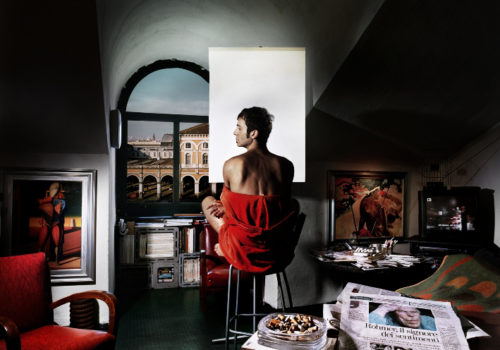Founded in 2003, Gagliardi Art System focuses its attention on young Italian and international artists who try to interpret reality by coupling techniques related to manual skill and “tradition” (from sculpture to sewing) with the kind of experimentation made possible by the new media and the freshness of a provocative, restless, but light-hearted look.
For MIA 2012 Gagliardi Art System proposes 2 young artist specific projects: Aurore Valade (Villeneuve sur Lot – France, 1981) and Glaser/Kunz (Olten – CH, 1968 / Zurich – CH, 1972)
The project Ritratti-Torino by Aurore Valade was created by the artist while residing in Turin with the support of the French Consulate. The project is the result of a unique, extremely accurate research and involves creating photo images composed according to the three genres of classical painting (portrait, interior and landscape) plus an array of other artistic and cultural references, organized according to an accurate study. The subjects are all Turin inhabitants. They are portrayed in profile, against a white background, inside their apartments. A window, or glass wall, is clearly visible in the background of each image, and through it you can glimpse a view of the city. The interiors are accurately designed by the artist, who personally chose the spaces and rearranged the furniture and objects so that the result could be adequately rendered in painting. Every photograph also contains references of current events in magazines or switched on televisions that have legible titles, after which the work is named. As we have mentioned, every image simultaneously contains three historical-artistic genres. The first is the portrait, again in profile. Here the model for the artist are Renaissance historical paintings, first and foremost the well-known Duke of Urbino by Piero della Francesca, but also photographs from entomology and cultural anthropology treatises that blend recent trends in contemporary art (for instance certain works by Thomas Ruff). The second genre is the interior, inspired by the atmospheres of Flemish paintings. The last is the view, again containing explicit references to Renaissance art. Each image is the product of painstaking photo-montage and photo-editing, aimed at giving photography the visual feel of a classic painterly work. However, despite these radical technical interventions and remakes, the artist clearly wills her photos to retain a realistic look, adhering faithfully to the objective truth of the moment when they were taken.
Glaser/ Kunz present at MIA a work from House of Homeless series.
JANE & WIL, Cinematographic Sculpture, New York/Torino 2010/11
2 Talking Heads, sound: 2-channels (English), ca. 150 x 150 x 90 cm
Two figures are sitting and talking to one another about the meaning of life and the philosophical and spiritual implications of finite existence. Their conversation is dominated by differing views, opinions and arguments. The characters recognize the lack of agreement; they are united in contradiction. The installation, with its simultaneously real and imaginary characters, forms a living organism that mirrors the roots of human existence as a paradoxical process of acquiring insight with utopian potential. The curiosity of visitors unites utopias and visions, inner and outer worlds. Through tolerance and openness, the leitmotiv of homelessness morphs into wisdom and humour. All of the characters are staged as video sculptures, as Talking Heads: they are three-dimensional heads with faces projected onto them. With no visible technology, they are bewildering and contaminate our thought models, making us respond with cautious empathy. They are captivating; we look into their eyes, silently examining their features and expressions; the characters seemed authentic and alive. Once we understand the context, there is an aha affect and we see the characters in a different light. The discrepancy between reality and fiction, the concrete exhibition, the contrapuntal staging all create a tension that subverts convention. The Talking Heads draw us into the abstraction of art and the reality of life. Confronted with the limits of what can be seen and perceived, we find ourselves enjoying the fruits of an unexpected school of perception.
Gagliardi Art System
Via Cervino 16
10155 Torino
gallery@gasart
tel. +39.011.19700031
fax. +39.011.19700032
















